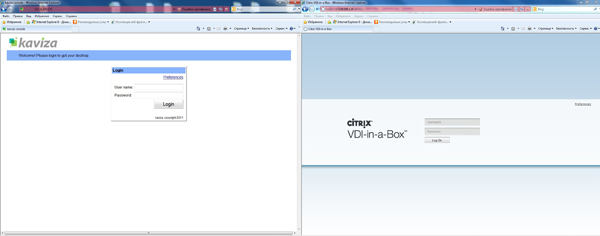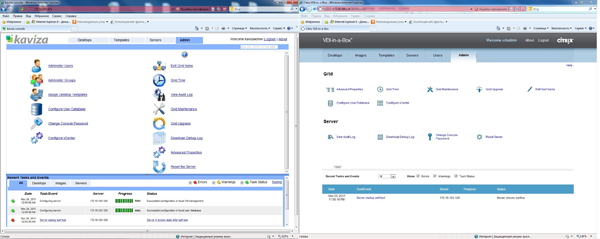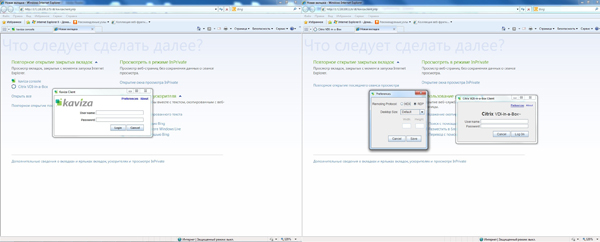New version of VDI-in-a-Box
Not so long ago, a new version of the VDI-in-a-Box product became available for download. This is an already revised version of one of Citrix’s latest acquisitions. Previously, this program was called Kaviza VDI in a Box (without hyphens =)). I had a chance to work with her, and despite a certain number of shortcomings, this product left me with pleasant memories of its ease of setup and ease of administration.
So, what has been changed in the new version.
1) Now VDI-in-a-Box is made on the basis of CentOS. I do not think that this will somehow affect the administration and user experience, but in Citrix presentations this feature of the new version takes an honorable first place.
2) Perhaps the most important innovation was support for Hyper-V. Now VDI-in-a-Box has become a truly universal tool for building an inexpensive VDI infrastructure. Hooray, comrades!
3) There are improvements in support for Citrix HDX, which allows streaming audio in real time, compresses traffic from webcams and generally improves multimedia performance.
4) As they say, they are met by clothes. The changed interface immediately catches your eye. The web page for logging into the management console itself has changed and acquired the Citrix logo.

You can also notice many changes in the management console. The windows became strict and restrained. In general, the layout of the interface elements remains the same. From the new - tabs for managing images and templates moved up.

5) On the Users tab, you can assign virtual machines to specific IP addresses. This is a very useful feature when using devices such as kiosks with dedicated IP.

How did this all turn out for end users?
Firstly, the choice between RDP and HDX protocols was lost when connected via the web interface. When working with a previous version of the product, I used the ability to connect via RDP when the HDX disconnected. It happened rarely, but the possibility of a choice calmed me somewhat.

RDP connectivity remains available if you connect through the Java Client. To do this, enter
http: // [kMGR address] /dt/kavizaclient.jnlp in the browser line .
As you can see, the appearance of the client has also changed.

Also, users have the opportunity to restart the desktop on their own if it freezes and does not respond to connection attempts.

In conclusion, I must say that no fundamental changes other than the support for Hyper-V, which had long been promised, did not appear. The solution is still pleasing with its simplicity and elegance.
All necessary documentation is here .
In addition, while working with the new version, I often used the documentation for the previous version, which is available on the Kaviza website .
Alexey Artyukhin, Systems Engineer, Digital Design
So, what has been changed in the new version.
1) Now VDI-in-a-Box is made on the basis of CentOS. I do not think that this will somehow affect the administration and user experience, but in Citrix presentations this feature of the new version takes an honorable first place.
2) Perhaps the most important innovation was support for Hyper-V. Now VDI-in-a-Box has become a truly universal tool for building an inexpensive VDI infrastructure. Hooray, comrades!
3) There are improvements in support for Citrix HDX, which allows streaming audio in real time, compresses traffic from webcams and generally improves multimedia performance.
4) As they say, they are met by clothes. The changed interface immediately catches your eye. The web page for logging into the management console itself has changed and acquired the Citrix logo.

You can also notice many changes in the management console. The windows became strict and restrained. In general, the layout of the interface elements remains the same. From the new - tabs for managing images and templates moved up.

5) On the Users tab, you can assign virtual machines to specific IP addresses. This is a very useful feature when using devices such as kiosks with dedicated IP.

How did this all turn out for end users?
Firstly, the choice between RDP and HDX protocols was lost when connected via the web interface. When working with a previous version of the product, I used the ability to connect via RDP when the HDX disconnected. It happened rarely, but the possibility of a choice calmed me somewhat.

RDP connectivity remains available if you connect through the Java Client. To do this, enter
http: // [kMGR address] /dt/kavizaclient.jnlp in the browser line .
As you can see, the appearance of the client has also changed.

Also, users have the opportunity to restart the desktop on their own if it freezes and does not respond to connection attempts.

In conclusion, I must say that no fundamental changes other than the support for Hyper-V, which had long been promised, did not appear. The solution is still pleasing with its simplicity and elegance.
All necessary documentation is here .
In addition, while working with the new version, I often used the documentation for the previous version, which is available on the Kaviza website .
Alexey Artyukhin, Systems Engineer, Digital Design
